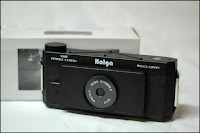While I confess that I don't really pay much attention to camera-themed events (with the exception of World Wide Pinhole Photography Day), Holga Week strikes me as a good opportunity to let the Holga love out.
I know, today is October 2, and Holga Week runs from Oct. 1-7. I've been working on issue 3 of Monochrome Mania, and it's totally focused on medium-format toy cameras...like the Holga. Last night I was going through sheet after sheet of negatives from my Holgas - and realized that I have almost 1000 images with them. Probably more than most people, so for me, a week isn't really a thing. Years, more like it - almost 20 years of Holgas. Of course I'll do some shots this week, because I would, anyway. However, I am always happy to see toy cameras get some love and attention, whether it's World Toy Camera Day, Diana Day, or Holga Week, it's all good. People need to understand that these plastic cameras are not just some bit of fun to get picked up now and then, but also that they are creative tools that let us show things in a different way. If images from Michael Kenna can't convince you that a Holga is a very special camera, then I guess nothing will.
I don't think that $40 for a Holga is outlandish. I have every Holga I bought, and almost 20 years later, my first Holga still works fine. Simply plastic fantastic, with a simplicity that will allow you to be creative. So, if you are on the fence about buying a Holga or using one, give it a try. It's still my favorite low-fi camera for a lot of reasons, and I own a half-dozen of the 120 models. I have owned the Holga 120 wide pinhole, and still have the Holga 135 Panoramic and Holga 135. Their plastic construction and plastic lens is part of the charm. Yet, the images made with them can be jaw-dropping beautiful.
The Holga 120N is easily modified, and a quick web search will reveal a lot of ways that it's been modified by people. Last year, I modified one my Holgas to have a hexagonal image mask. I am doing a long-term project with it, and hope to have some interesting results. A lot of people have asked if the Holga is a good introduction to medium format photography. My answer is no. Your expectation of medium format is a larger, more detailed negative -- and you'll get that with a twin-lens reflex as the entry to medium format. The Holga and the Diana and similar low-fi 120 cameras will give you something, but you need to know the limitations and make them work for you in composition, lighting, and subject.
Another point is that because the Holga has limited adjustments for exposure, you can easily tape a colored orange, yellow, or red gel over the lens to compensate in b&w film, or use a neutral density filter for color (and yes, it works for b&w, too). You can also use an external flash for poorly lit situations, or use the B setting while on a sturdy tripod for long exposures. An adapter allows you to use studio strobes for anyone wishing to do so. You can add a thread mount filter ring to the front of your Holga by firmly screwing in a 46mm to 49mm adapter ring, allowing you to use 49mm filters.
The Holga 120N takes readily available 120 film. In bright daylight, 100 ISO film is fine, but 400 ISO film will be fine in almost any situation. If you haven't used a Holga before, don't sweat it. Before long, you'll appreciate its quirky features, and think less about the use, and more about the image. Light leaks? I just use artist's black masking tape or gaffer tape. My biggest fear is that the back will come loose, so I use gaffer tape over the metal clasp on each side to avoid that. That's pretty much the only weakness of this plastic fantastic icon of the toy camera world.
And now, for some images from over the years from my Holga cameras:


















No comments:
Post a Comment